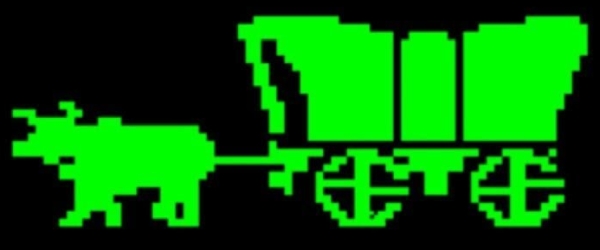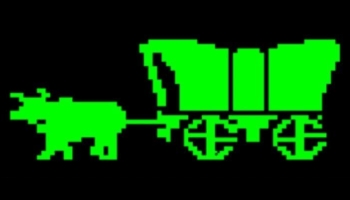
Demographers love to refer to people born between 1977 and 1985 as the “Oregon Trail Generation.” Born on the borderline between Generation X and Millennials, members of the Oregon Trail Generation grew up using analog technology like rotary phones and rabbit ears, but they also became proficient in using computers and the Internet (often thanks to The Oregon Trail) while still in school.
However, an even earlier generation got a chance to play The Oregon Trail before it was immortalized in the glowing greens of an Apple IIe. So let’s travel back to 1971 and meet one of the game’s first players in this edition of Bite-Sized Game History.
And stick around to explore the connection shared between Ryu and Kevin Bacon, as well as the secret origin of Noob Saibot.
![]() You can find a lot of dedicated video game historians on Twitter, and in 280 characters or less, they always manage to unearth some amazing artifacts. Bite-Sized Game History aims to collect some of the best stuff I find on the social media platform.
You can find a lot of dedicated video game historians on Twitter, and in 280 characters or less, they always manage to unearth some amazing artifacts. Bite-Sized Game History aims to collect some of the best stuff I find on the social media platform.
Console players had gotten used to seeing logos for companies like Nintendo, Capcom, and Sega when they booted up their favorite game in the 1980s, but a different name greeted PC players at the beginning of The Oregon Trail… MECC. The Minnesota Educational Computing Consortium was founded in the early 1970s to study the educational impact of computers and mainframes in schools, but the group quickly branched out into software development, and they took over development of The Oregon Trail from Don Rawitsch in 1975.
Rawitsch, along with Bill Heinemann and Paul Dillenberger, originally created the game in 1971, and it was first played by students like Prince Nelson at Bryant Junior High School in Minneapolis. It’s unknown if Nelson ever took a turn with The Oregon Trail, but he had a much bigger claim to fame after he dropped his last name and released songs like “1999” and “When Doves Cry.”
Yes, Prince Nelson of Bryant Junior High School was that Prince:
"The Oregon Trail" turns 50 this year.
In the fall of 1971, the computer game was created for student teacher Don Rawitsch's 8th-grade history classes at Bryant Junior High in Minneapolis.
In the fall of 1971, Prince was an 8th-grader at Bryant Junior High in Minneapolis. pic.twitter.com/WFO0lSpPIV
— Casey Common (@CaseyCommon) April 9, 2021
Street Fighter‘s Ryu is a martial artist always in search of his next challenge. This wandering spirit has been a huge part of his characterization since his debut in 1987 and it’s served him well in the string of crossover appearances he’s racked up over the last three decades in games as diverse as Marvel Vs Capcom, Super Smash Bros. Ultimate, and Fortnite.
It’s that last one that gave Corwin Brence the idea for the Ryu Number, a game-based spin on “Six Degrees of Kevin Bacon”:
So, I think the gaming world is already pretty well aware that Street Fighter's Ryu has worked with (or fought) almost everything in video gaming. But I see hardly anybody thinking about it from a Kevin Bacon lens. So, let's ponder: The 6 Degrees of Ryu, or #RyuNumber for short. pic.twitter.com/ZNaqkt5bie
— weasel slightly knows how to play mahjong now (@CorwinB87) April 16, 2021
Street Fighter II’s main competition for quarters in the early 1990s arcade scene was Midway’s Mortal Kombat, and that was partially due to co-creator Ed Boon’s love of secrets. Every fighting game fan wanted to discover a new Fatality or earn a match against Reptile, and this chase for secrets only intensified once Mortal Kombat II was released.
Midway was happy to tease the existence of Jade and Smoke in the game’s “Living Forest” stage, but a third secret character was hidden behind even stricter requirements… and no one besides Boon even knew he existed. Noob Saibot was an all-black ninja created by combining a reversed version of Boon’s name with that of co-creator John Tobias.
Players had to win 50 matches in a row in order to challenge Noob Saibot, and this was so difficult to pull off that Tobias admits that development on Mortal Kombat 3 was already well under way before he saw the character for the first time:
Funny thing is, I just realized that Smoke/Jade as secret characters in #MortalKombat 2 may have been part of an elaborate joke on me by @noobde … (thread) https://t.co/LXXrsUmsrT
— John Tobias (@therealsaibot) April 17, 2021
In case you were wondering, the entire cast of Mortal Kombat can be linked to Ryu in three steps at most (via The Terminator’s appearance in Mortal Kombat 11, believe it or not).
Thanks to Casey Common, Corwin Brence, and John Tobias for posting these bite-sized history lessons. Be sure to follow me on Twitter to see more trivia tidbits like this in the future.

